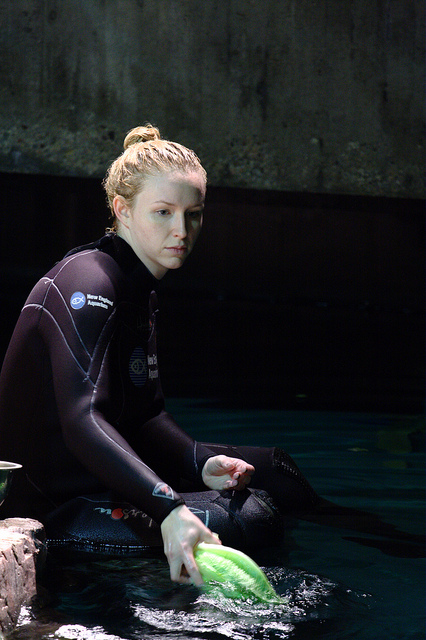“National Volunteer Week is about inspiring, recognizing and encouraging people to seek out imaginative ways to engage in their communities. It’s about demonstrating to the nation that by working together, in unison, we have the fortitude to meet our challenges and accomplish our goals. National Volunteer Week is about taking action, encouraging individuals and their respective communities to be at the center of social change—discovering and actively demonstrating their collective power to foster positive transformation.” — Points of Light Foundation
 |
| Volunteers at the Aquarium answer visitors' questions about our animals and exhibits. | Photo: Arturo Gossage |
With about 1,000 volunteers, interns, and teens donating more than 109,000 hours of service to the New England Aquarium, we know that
volunteers are core to the function of our organization. To put that lofty number into perspective, this donation of service hours is the rough equivalent of an additional 61 full-time staff members to the Aquarium team. With a regular workforce of 250 paid staff, this contribution is extremely significant.
Additionally, these volunteers go above and beyond their service hours in their role as our ambassadors to the community at large. By spreading their Aquarium experiences through personal passion and word of mouth, they also spread our mission in an organic way. It is clear to all of our staff that without our volunteers we would not be able to offer many of the programs, experiences and services we currently provide as we strive to fulfill our mission of protecting the blue planet.
 |
| Live animal presentations are another way volunteers can interact with the public. | Photo: Arturo Gossage |
And this is just our small piece of the overall volunteer world. We are humbled by the knowledge that throughout 68 zoos and aquariums surveyed by the Association of Zoos & Aquariums in 2011, 42,533 volunteers served more than 2,489,093 hours in benefit to our national mission of environmental education and conservation. As we look to service throughout our nation it warms our heart even more to know that these numbers expand exponentially when we consider all of the different ways an individual can volunteer from mobilizing during emergencies to packaging meals at a local food bank.
 |
| Some volunteers work behind the scenes | Photo: Arturo Gossage |
At the core of volunteering is the ability for an individual to stand back and see the immediate need of his community and make the corresponding change. Volunteers possess the ability to acknowledge that someone or something (be it a veteran in need of a meal, a
cold-stunned sea turtle or a park in need of a cleanup) needs an extra hand that only they can provide. These incredible individuals then give of their free time, energy and passion to fix that community need. What is most interesting in this chain of events is that, often, these self-less acts lead to other acts of service. Study after study of service and volunteerism have shown that volunteers are more likely to give financially, more likely be active in their communities and more likely to become civically engaged than other members of our society.
 |
| Our animals have to eat! Many volunteers help with food preparation. | Photo: Arturo Gossage |
If you currently serve, either at the New England Aquarium or elsewhere throughout our community, we would like to thank you for your incredible donations of time, energy and passion. We know that it can be hard to take time out of our daily lives for the betterment of another, but each time you do our community is indebted to you!
This April 22 – 27, New England Aquarium will be celebrating service by featuring some of our incredible volunteers and a variety of service opportunities. To start the week off right, we thought we would show you a few different ways you can get involved and start volunteering today:
•
Become
a regular volunteer with New England Aquarium and commit to serving with our animals, guests, community programs, or administrative roles.
•
Need a more flexible commitment? Sign up to become an
Aquarium one-shot volunteer!
•
Not in Boston or interested in working with other kinds of animals? Find
another AZA institution near you that needs volunteers.
•
Consider a citizen science program like
Frog Watch USA.
•
Boston Cares has a fantastic calendar of “click to sign up” service opportunities throughout Greater Boston focused on a diverse array of impact areas from homelessness to education.
•
You can learn about national service initiatives and find a local volunteer action center by visiting
HandsOn Network.
•
Miles of Good: 26.2 Days of Inspired Acts of Kindness is an initiative started to increase community goodwill in response to the tragedy on Marathon Monday.
































